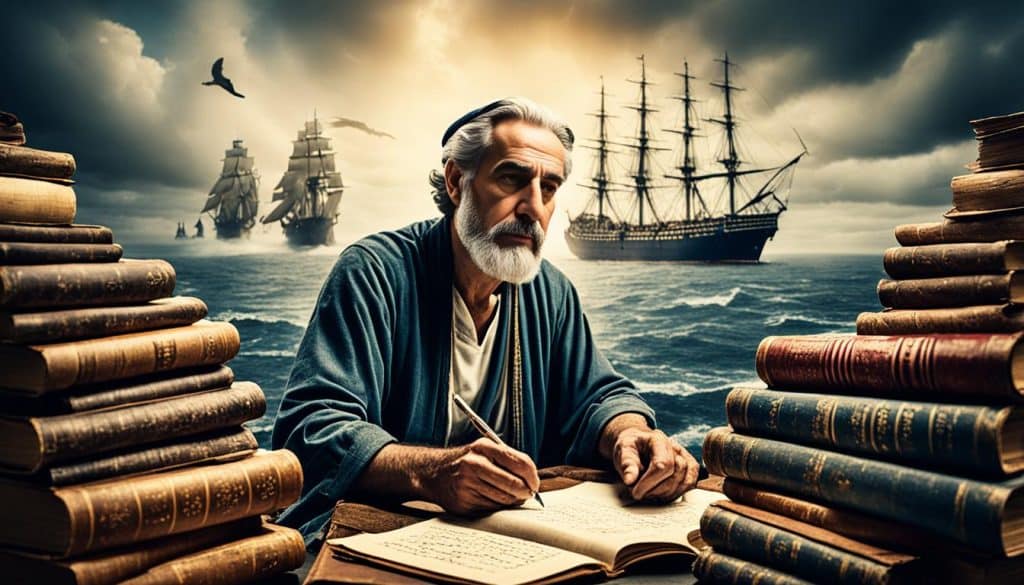Have you ever stopped to think about the stories that bring us together? Personal narratives – full of triumphs, struggles, love, and sorrow – connect us deeply. They help us understand the extraordinary in our everyday lives. They show us the rich, varied experiences that weave our collective history.
In New York City’s streets, history comes alive with amazing stories. You’ll find David C. Driskell’s captivating journal from China in 20081, and tales of resilience from WWII prisoners of war1. George Washington Pearcy and Captain Robert Augur’s experiences remind us of our unbreakable spirit.
In this collection, we also honor often-unheard heroes. Like Elizabeth Keckley, an enslaved woman who bought her freedom and became a famous White House dressmaker and memoirist2. Their stories are powerful glimpses into our history and humanity.
Take Mary Church Terrell’s autobiography, “A Colored Woman in a White World,” published in 19401. It’s not just her story, but a piece of history, showcasing her fight for civil rights.
Diving into these narratives, we realize they’re more than memories. They connect us, teach us empathy, and give us insights. They challenge us to see our stories in theirs, changing how we see the world. So, explore the Personal Narratives Collection. It might just change your perspective.
Read more about how these inspiring stories are recorded for the future.
Key Takeaways
- Personal narratives create a bridge of understanding and empathy between different generations and cultures.
- Exploring inspiring personal stories reveals profound insights into human experiences.
- Rich historical personal narratives highlight the contributions of lesser-known heroes throughout time.
- David C. Driskell’s journal and Mary Church Terrell’s autobiography offer invaluable perspectives on their respective worlds.
- Reading real-life narratives can reshape your perceptions and inspire new reflections on your own life experiences.
An Overview of Personal Narratives
Understanding personal narratives is key to knowing the full scope of human experiences. They not only shape who we are but also shine a light on history and culture.
What is a Personal Narrative?
A personal narrative tells the story of someone’s life. It focuses on important moments and experiences. These stories can be in many forms, like memoirs, diaries, and even songs3. For example, students can send their stories to the Leonardo journal3. This is especially meaningful for people who use Augmentative and Alternative Communication (AAC)4.
When defining a personal narrative, it’s important to use elements like theme and plot3. These components make the story engaging and relatable. Stories by people like Elizabeth Keckley offer a priceless look at history2.
The Power of Storytelling
Storytelling’s power comes from its ability to create empathy. It lets us share personal and shared experiences. For AAC learners, it can help in expressing emotions and organizing their stories4. Techniques like visual aids help make these stories clear4.
Creative writing, like memoirs and novels, dives deep into personal stories. They do more than entertain; they teach us new perspectives. A story needs elements like plot and characters to keep readers hooked3. This makes sure the story flows and has impact.
Historical adventures, such as those by Lewis and Clark, offer personal views that enrich history2. Today, stories from people like Britney Spears also add to our understanding of events2. Using strong storytelling, personal narratives bring to life the rich tapestry of human experience.
NYC & Me: Connecting Personal Stories with History
Joining NYC & Me workshops is a unique way to combine your own stories with New York City’s history. These workshops are led by Kelly Jean Fitzsimmons, known for her expertise in narrative writing.
Exploring NYC’s Forgotten Figures
In the workshops, you’ll learn about forgotten heroes of NYC history. Over six weeks, you will discover stories hidden in places like Green-Wood Cemetery and the 1964 World’s Fair. You’ll feel a deep connection to history and be inspired to write your own story5. You’re asked to write a draft of your story, inspired by what you learn5.
We focus on important yet unrecognized figures who shaped NYC. Your tasks include finding new stories and thinking deeply about NYC’s past. This helps improve your writing5.
Interactive Workshops with Kelly Jean Fitzsimmons
The sessions involve active storytelling, guided by Kelly Jean Fitzsimmons. You’ll learn how to make your stories come alive, combining history and personal touch. The workshops offer a chance to share your drafts, get feedback, and polish your writing5.
By the end, you’ll reflect on the connections you’ve made with NYC’s history through your stories5. With personalized feedback, you’ll end with a story that ties closely to New York’s historical heart5.
Remarkable Stories from StoryCorps
StoryCorps gathers stories that show the different paths people take in America. It celebrates victories and how people keep going, even when it’s tough.
Brightness in Black: Celebrating Black Life in America
Brightness in Black shares the ups and downs of being Black in America. Through these stories, everyone can learn and feel more connected. They show the mix of challenges and achievements in the African American journey.
Personal Stories of Triumph and Resilience
These stories focus on big personal wins. They show how storytelling can help people overcome tough times. Many stories are about brothers and sisters growing up and fixing their relationships.
They come from all over the place: New York to Hawaii. They talk about big issues like health, family, and where you come from6. StoryCorps helps us see the beauty in America’s diverse stories.
Mary Sheppard Burton: Preserving Family Stories Through Art
Mary Sheppard Burton has left a big mark by telling her personal family narratives through hooked rugs. Her work in visual storytelling not only celebrates her family’s history but also plays a big part in art preservation.
Hooked Rugs as Storytelling Medium
Mary Sheppard Burton used hooked rugs to share her family’s stories. These rugs are more than art—they keep family memories alive for future generations. Works like “The Law of Love” and “Between Two Fires” show how deeply she cared about personal family narratives7.
The Secret Place: A Personal Family Tale
“The Secret Place” is one of Mary’s most famous rugs. It shows a special memory of her mom enjoying a book under a cherry tree. This piece is a beautiful example of how visual storytelling can capture precious family moments8. In her “Tell Me ‘Bout” series, Mary shares many personal stories. This connects viewers with the tradition of art preservation. It shows just how powerful stories can be in keeping memories alive8.
Writers like Constance Sayers and Laura Esquivel also keep personal stories alive through their books. Their works, published up to 20219, and studies on social changes in New York families show the importance of storytelling in different forms8.
Diaries and Their Historical Significance
Historical diaries give us a special look into the past. They tell personal stories that aren’t usually in history books. These diaries are key to keeping personal history alive. They show us the daily lives, feelings, and challenges of people during hard times.
Prisoners of War: Diaries from WWII
Diaries from World War II prisoners, like those by George Pearcy and Robert Augur, share real-life experiences of being captured. They show how strong the human spirit can be. About 57% of diaries shed light on war, making them very important for history10. These stories are so powerful, they’re often turned into movies and TV shows10. These diaries let us peek into the lives of soldiers and give context to WWII events.
Preserving Personal Histories
The Great Diary Project works hard to save over 8,000 diaries and is always collecting more. They make sure these precious documents are well kept by following the best conservation standards11. This effort shows how vital it is to save personal stories for the future. Experts recommend specific ways to store diaries and share wishes about keeping them safe12. Donating diaries to places like libraries or archives helps keep them safe12.
About 71.4% of diaries mix personal stories with big historical events, making them valuable for researchers10. Also, the fact that 42.8% of these diaries have been turned into other forms of media shows their huge impact10.
| Statistical Data | Percentage |
|---|---|
| Diaries related to wartime experiences | 57% |
| Diaries focused on the 20th century | 5:2 |
| Adaptation of diaries into films/TV shows | 42.8% |
| Diaries with a mix of personal and historical contents | 71.4% |
Autobiographies on Broadway
Broadway autobiographies give us a personal and in-depth look at the stars of theater. Neil Simon is a key figure in this world, known for his huge success. His stories are a major part of playwriting history.
Neil Simon’s Unparalleled Broadway Success
Neil Simon has had a huge impact on theater storytelling. Works like “Brighton Beach Memoirs” show how personal stories can become big hits. His autobiographies explore his career and the personal stories behind his plays. They talk about overcoming challenges, finding humor, and the importance of family.
These aspects make Simon’s journey relatable and inspiring. They show us how personal experiences can lead to creative success.
From Handwritten Scripts to Broadway Hits
Neil Simon’s path from notes to famous plays is incredible. He was very careful in how he crafted his plays. His autobiographies reveal how his early drafts turned into famous shows.
Other Broadway memoirs share personal and professional hardships. They share stories of meetings with famous people like Marilyn Monroe. They talk about tough times like fighting cancer or coping with loss13. These books are full of photos that bring these stories to life13.
Books like Moss Hart’s “Act One” have inspired the theater world since 195914. Harvey Fierstein’s “I Was Better Last Night” offers a look at his career in TV, film, and theater14. These memoirs create a connection between written scripts and stage performances through storytelling.
| Book Title | Author(s) | Page Count |
|---|---|---|
| Affective Memories: How Chance and the Theater Saved My Life | Unknown | 480 |
| I’m No Philosopher, But I Got Thoughts: Mini-Meditations for Saints, Sinners, and the Rest of Us | Unknown | 224 |
| Finding Me | Viola Davis | 304 |
| This Time for Me: A Memoir | Unknown | N/A |
| Diva 2.0 12 Life Lessons From Me For You | Unknown | 172 |
| Gilmore Girl: Life on Broadway | Melissa Manchester | 210 |
| Lord Knows, At Least I Was There: Working with Stephen Sondheim | Unknown | N/A |
| Twenty-five years of diaries, from thoughts and insights on theater performances, the craft of acting, politics, friendships, work projects, and his general musings on life | Allan Rickman | 480 |
| The Book of Joel | Unknown | N/A |
Artistic Personal Narratives: David C. Driskell’s China Journal
David C. Driskell shared his journey through China with vibrant color drawings and notes. His journal gives us a glimpse of his adventures and thoughts, showing us how he changed American art.
Color Drawings and Handwritten Observations
Driskell’s journal from China shows his skill and creativity. It mixes colorful drawings and notes, making a lively diary of his travels. His detailed and colorful art reflects his strong feelings for the places he saw.
He combined pictures and words to tell stories about art and culture. This makes his journal a valuable collection that reveals his deep understanding of art.
Impact on American Art History
David C. Driskell played a big role in American art history. He spotlighted African-American art, creating the “Two Centuries of Black American Art” exhibition in 1976. This show, featuring around 200 pieces from over two centuries, was a hit in several cities and shed light on Black artists’ work.
Even though some critics had mixed feelings, the show helped fight for Black artists’ recognition. Driskell’s work keeps reminding us of the exciting and vital art by Black Americans.
His China journal and artworks like “Mask and Shadow” are still praised. They show his influence on art and culture. His work connects cultural experiences with history, teaching and inspiring others.
Driskell didn’t just create art; he supported big social and cultural shifts. His story, shown in his art, is linked to the broader story of Black artists in America. It’s a story that continues to touch lives through exhibitions and projects that honor Black artists.
David C. Driskell’s visual diaries and notes from his China trip make him a key figure in American art. He links cultural experiences with history, creating a rich story that inspires future artists.
| Key Contributions | Details |
|---|---|
| Two Centuries of Black American Art | Groundbreaking exhibition featuring approximately 200 works from the mid-18th to the mid-20th century15. |
| Popular Reception | The exhibition drew large crowds across multiple cities including Los Angeles, Dallas, Atlanta, and Brooklyn15. |
| Struggle of Black Artists | Highlighted the challenges Black artists faced in being recognized by the mainstream art world15. |
| Conceptual and Urgent Art | Recent recognitions have emphasized the conceptually exciting and urgent-minded American art produced by Black artists15. |
Personal Narratives Collection: Home Movies
Home movies are a key part of personal storytelling and visual narratives. They capture special moments and keep family history alive for those who come after us. These candid personal documentation pieces show the day-to-day lives of people, providing a unique view into history. The Jean Patton Collection, with over a hundred reels from the 40s to the 70s shot by Jean Patton and her husband Robert in Chicago, is a great example of this16.
The South Side Home Movie Project shows the Jean Patton Collection on their site. It includes family trips to places like Yellowstone National Park and Denver, Colorado in 196616. This kind of personal storytelling gives us a peek into American culture after the war. Families visiting landmarks like the Grand Canyon showed their love for the country16.
The African American Home Movie Archive (AAHMA) was started by Jasmyn R. Castro in 2014. It has the Black Home Movie Index, with films from the 1920s to the 1980s16. These visual narratives from the Civil Rights era show African American families’ lives. They make a statement about identity in times of change16. The National Museum of African American History & Culture (NMAAHC) also has a large collection of these home movies. They offer a deep look into African American stories16.
Home movies are also important for learning. The Eisenhower Presidential Library shares digitized records on big events like D-Day and the Civil Rights movement17. Places like the George W. Bush Presidential Library and the Kansas State Historical Society use artifacts to help students learn history hands-on17. These efforts show the value of keeping family history through candid personal documentation and artifacts.
Personal stories can also have deep meanings. They cover topics from tech addiction to how we see Mother’s Day. These stories help question social norms and explore who we are18. Using drama and metaphors, they show how personal and family history affect our culture18.
| Collection | Description | Time Period |
|---|---|---|
| Jean Patton Collection | Over 100 reels of home movies by Jean and Robert Patton | 1940s-1970s |
| African American Home Movie Archive (AAHMA) | Black Home Movie Index by Jasmyn R. Castro | 1920s-1980s |
| National Museum of African American History & Culture (NMAAHC) | Vast collection of African American home movies | Focus on Civil Rights era |
| Eisenhower Presidential Library | Digitized documents on historical events | Various |
| George W. Bush Presidential Library | Traveling trunks of artifacts for education | Various |
Mary Church Terrell: The Life of a Civil Rights Pioneer
Mary Church Terrell was a leading figure in education and civil rights. She was born on September 23, 1863, in Memphis, Tennessee. Terrell fought against societal norms of her era19. She was a key member of the NAACP19. She helped break down racial barriers.
A Colored Woman in a White World
Terrell’s autobiography offers a deep look into her life and the civil rights struggles she faced. Her book shares her victories and the obstacles she battled. It underlines the role of African American women during a crucial historical period20. She published her story at seventy-seven with her own money20. For more information, visit the Civil Rights Movement Juvenile Collections.
Breaking Boundaries and Inspiring Generations
Mary Church Terrell was a trailblazer in both women’s rights and civil rights. From 1895 to 1906, she served on the school board in Washington D.C., a first for an African-American woman19. Terrell earned degrees from Oberlin College, becoming one of the first African-American women to do so19. She wrote many pieces on black women’s history, which have often been overlooked20. As the first president of the NACW, Terrell pushed for civil rights and the right to vote for women19.
A Remarkable Autobiography: Omar Ibn Said
Omar Ibn Said’s autobiography is a distinctive record of an enslaved scholar in America. Written in Arabic, it offers unique insights into the life of a Muslim with extensive education. He was captured and enslaved in the early 19th century.
An Enslaved Scholar’s Memoir
Omar Ibn Said, born around 1770, belonged to the Fula people in West Africa. This area is now home to over 40 million people. He studied in Bundu, Senegal, learning from his brother and other leaders21. In 1831, he wrote about his capture and life as a slave in North Carolina21. His Arabic manuscript remains the sole detailed account of such experiences in America, showing the intellect and faith of an enslaved Muslim22.
The Only Memoir of Its Kind Still in Existence
The Omar Ibn Said Collection has 42 documents in English and Arabic21. Many written by a West African slave in Panama and others from West Africa. These works prove the high literacy and education levels in that region21. Omar’s writings break down stereotypes, highlighting the mental strength and endurance of enslaved individuals through his perspectives23.
Abolitionist Theodore Dwight gathered these writings in the 1860s. They help researchers study Africa, American slavery, and Islam among enslaved Africans21. Omar wrote in Arabic, and Alexander I. Cotheal translated it in 184822. His manuscript is a critical piece of history, documenting the life and thoughts of an enslaved Muslim in America21.
Omar Ibn Said’s story highlights his Islamic study and his spiritual path23. Captured and brought to Charleston in 1807, he came a year before the U.S. ended the slave trade23. Later owned by James Owen, Omar embraced Christianity, adding complex layers to his identity23. His story is a testament to his enduring faith and scholarship.
The Power of Visual Art in Telling Personal Stories
Visual art storytelling uniquely shares complex stories and touches hearts. The story of Spider-Man, drawn by the talented Steve Ditko, is a key example. It shows Peter Parker’s life change from a quiet student to the beloved superhero, Spider-Man.
Spider-Man’s Origin Story by Steve Ditko
Steve Ditko is unmatched in comic book art. His work crosses cultural and language limits, uniting people through emotions and shared stories24. His depiction of Spider-Man’s beginning brings Peter Parker’s change to life. It also deeply moves readers, inviting them to see the story through their eyes24.
Ink, Opaque White, and Graphite Drawings
Ditko’s use of ink, opaque white, and graphite has created unforgettable scenes. His detailed method uses symbols, colors, and layouts to bring characters and their worlds to life24. He adds tiny details that deepen each image. This helps with exploring characters and making the story clear. Ditko draws viewers into the story’s heart with every frame25.
Ditko’s art shows the power of visual storytelling. His illustrations evoke emotions and spark curiosity in the viewers25. Thus, Ditko’s Spider-Man artwork stands as a landmark. It shows how art can go beyond the pages to make a lasting impact on readers.
Connecting Generations Through Personal Narratives
StoryCorps helps bring people together by telling stories. They focus on making connections through tales that touch everyone, no matter their age. By doing this, they build bridges between generations and spread empathy.
StoryCorps’ Mission of Building Connections
StoryCorps aims to create strong bonds between people through stories. For example, their “grandbuddies” program brought together older adults and kids for storytelling at O’Hara Elementary School26. This shows how sharing stories can create lasting friendships between different generations.
Engaging Programs and Initiatives
StoryCorps has many programs that gather and share people’s stories. Libraries host events that include everyone from kids to older adults26. The National Storytelling Network helps find storytellers, making it easier to keep cultural traditions alive by preserving family tales26. This effort helps keep our heritage and family memories safe27.
Family stories bring us closer and give us a sense of belonging27. They allow us to share important life lessons and grow closer to each other27. Sometimes, it costs between $100 and $500 to get a professional storyteller, depending on where you are and their experience26.
StoryCorps plays a vital role in collecting our shared stories. This work helps to keep our cultural stories alive and connects our community in meaningful ways.
Cultural Impact of Personal Narratives
Personal stories greatly enrich a society’s cultural heritage. They let us dive deep into collective memory. This helps us understand and value the varied experiences of humanity.
Personal stories shape not just individual views but society’s norms, too. Studies reveal sharing stories raises empathy by 77%, making society more inclusive. History Chip noted a 45% boost in story sharing, showing a keen interest in saving these narratives28.
Storytelling benefits everyone, from kids to the elderly. It can lower stress by 62% and improve well-being by 81% in storytellers28. In schools, kids creating stories predicts their future reading and academic achievements29.
Stories can break stereotypes and change views 91% of the time28. They push for social change in 68% of instances, leading to talks about cultural progress28. Story elements vary across cultures, like in English-speaking versus East Asian kids’ tales29.
Sharing and saving personal tales makes community memory richer. Programs like Atlantic Fellows for Equity in Brain Health show this. They bring together experts to tackle aging, health policy, and more30. Storytelling in medicine helps 80% of patients share their issues in two minutes, if listened to carefully30.
Exploring community stories shows how they build understanding, empathy, and connections. These narratives make society and the art of storytelling richer. They help us create a world that’s more connected and caring.
The Importance of Preserving Personal Narratives
Keeping personal stories alive is essential. It makes sure we don’t forget important life experiences. These stories are full of wisdom, lessons, and motivation that connect people across different times.
By using good ways to store these stories, we keep the true essence of personal history for later. This is important for learning and sharing in the future.
Why Personal Stories Matter
Personal stories are key to the legacy of people and their communities. They help us learn from before and see the world through others’ eyes. By sharing these stories, we feel more empathy and see the beauty in different lives.
Keeping memories through history books, diaries, life stories, and art is important. With the right ways to keep these memories safe, we ensure they can teach and inspire later on.
Methods of Preservation
There are many ways to keep personal stories safe. We can turn papers and sounds into digital files, keep physical records, and use online storage. These steps are vital to make sure personal history lasts.
As laws and society change, we might need new ways to protect these stories because of historical laws or recent decisions. Groups like StoryCorps and The Tulane Hullabaloo show how personal stories improve journalism31.
People: Personal Narratives Collection – A Journey Through Time
Personal stories open a door to the past, sharing a range of experiences. Around 397,000 kids are in foster care in the U.S. Their stories show the many lives behind these numbers. It’s key that we listen and keep these stories32.
“Our ability to tell our story, individually and collectively, is so much at the core of what it is to be human, and what made this country the way it is.”— David Isay, StoryCorps Founder.
Stories like “Humboldt’s Personal Narratives of South America” from 1907 capture our history in detail33. Spread over three volumes, the first volume focuses on South America’s nature and geography33. These stories help us understand our world better.
About 65% of recommended books by Black authors or about Black history show why these stories matter34. Stories on racial equality and civil rights make up 20%, showing the fight for a better society34.
Forty percent of these books share family stories across generations34. Stories on slavery are in 35% of these books, highlighting its deep impact on our history34.
The People’s Personal Narratives Collection isn’t just a collection. It’s a rich tapestry of our shared history. By reading these stories, we understand different cultures and times through personal experiences.
Conclusion
The ending of our article highlights the strong influence personal stories have. Through different life stories, we see how connections are formed. Stories of triumph and hardship, like those from NYC or Mary Sheppard Burton, teach and inspire us. They show us the deep impact personal stories have by offering new views and deep insights.
Looking into diaries, autobiographies, and art lets us see wider themes in personal reflections. Figures like Mary Church Terrell and Omar Ibn Said stand out with their vivid stories. Their tales prove how powerful storytelling can be35. Stories used in classrooms, mentioned by teachers like Gabriela Calderon-Espinal, help students feel more empathy36. Also, personal stories in marketing, as Neil Taparia shows, make audiences care more37.
In the end, the People: Personal Narratives Collection saves important stories for the future. It has everything from old diaries to recent autobiographies. Each story helps us understand our world better, leaving behind a rich history of human experiences. We hope these stories motivate you to share your own, adding to our collective history.







